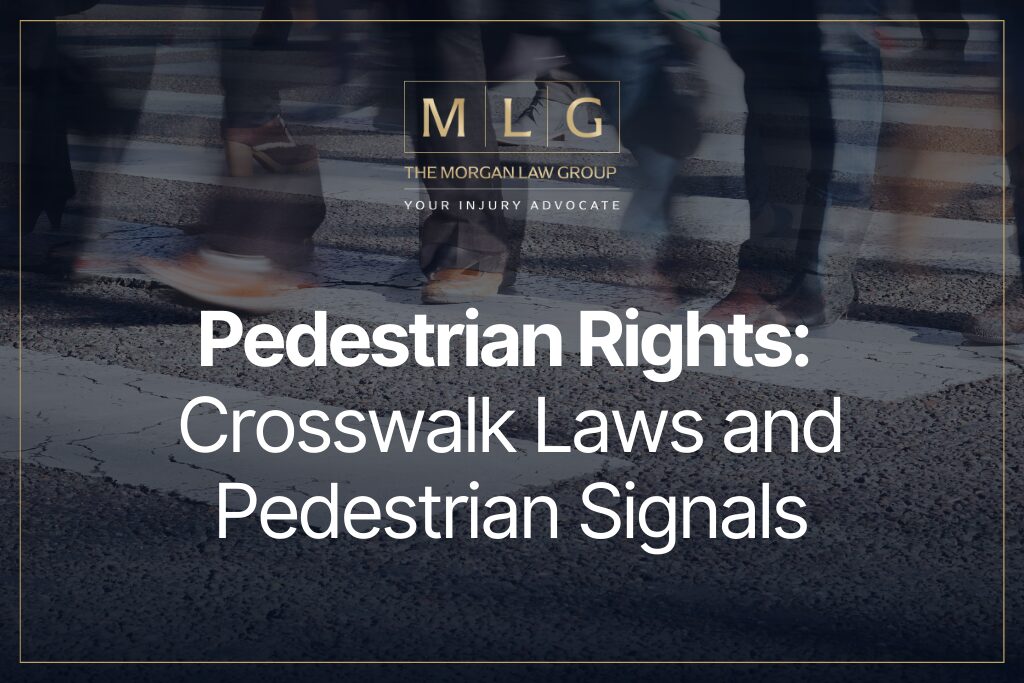As a pedestrian, understanding your rights and the laws surrounding crosswalks and signals in Florida is crucial for your safety. Sadly, pedestrian accidents are all too common even in our state, often due to negligence or lack of awareness.
This article aims to shed light on pedestrian rights in Florida, offering critical information to protect yourself and ensure you navigate the roads safely. But when an accident persists, our Florida pedestrian accident attorney at The Morgan Law Group is committed to advocating for those injured in accidents.
Florida Crosswalk Laws
Florida has developed specific statutes aimed at safeguarding pedestrians as they navigate the state’s roadways, particularly in crosswalk areas. These laws are integral to maintaining safety and ensuring a harmonious coexistence between pedestrian traffic and vehicular movements.
- Right of Way: In Florida, pedestrians are granted the right of way in all marked crosswalks. This pivotal rule mandates that drivers must yield to pedestrians who are either already in the crosswalk or are stepping into it. The law aims to prevent accidents by giving pedestrians precedence in these designated areas, thereby encouraging drivers to approach crosswalks with increased awareness and caution.
- Unmarked Crosswalks: Even in the absence of marked crosswalks, Florida law extends pedestrian right of way at intersections. This provision underscores the expectation that drivers should remain vigilant and yield to pedestrians crossing the street directly at intersections, regardless of whether the crosswalk is visibly marked.
- Mid-Block Crossings: Florida law advises pedestrians to use designated crosswalks or intersections whenever possible. However, the law also accommodates scenarios where no crosswalk is available within a reasonable walking distance. In such cases, pedestrians are permitted to cross the street, provided they do so cautiously and at a suitable location, ensuring they do not disrupt the flow of traffic.
- Driver Responsibilities: Drivers have a heightened duty of care when navigating areas frequented by pedestrians. This includes the responsibility to yield to pedestrians in crosswalks and to refrain from passing other vehicles that have stopped to allow pedestrians to cross. This rule is crucial for preventing accidents and for protecting pedestrians from drivers who might otherwise disregard their presence.
- Pedestrian Responsibilities: While pedestrians enjoy the right of way in crosswalks, they also bear certain responsibilities to help avoid accidents. They must exercise proper caution and avoid entering a crosswalk impulsively or without ensuring that it is safe to do so. Pedestrians should ensure that their actions are predictable to oncoming traffic, thereby reducing the risk of sudden accidents.
Understanding and respecting these is essential for all road users in Florida. For pedestrians, knowing your rights and responsibilities enhances your safety. For drivers, awareness and adherence to these rules are critical in preventing accidents and in fostering a safer environment for everyone.
Signals for Pedestrians in Florida
Pedestrian signals are crucial tools in urban planning, designed to regulate the interaction between pedestrian and vehicular traffic. These signals are tailored to enhance safety by providing clear, visual cues that help pedestrians navigate crossings safely.
- Walk Signal: The “Walk” signal is perhaps the most straightforward of pedestrian cues; it indicates that pedestrians have the green light to cross the street. When this signal is illuminated, pedestrians can proceed with confidence knowing they have the right of way. It is a clear indication that traffic has been halted to allow safe passage.
- Flashing Don’t Walk: A flashing “Don’t Walk” signal serves a dual function. It warns pedestrians that the window to safely begin crossing is closing. However, for those already in the crosswalk, it provides assurance that there is still enough time to reach the opposite side safely. This signal is crucial for preventing pedestrians from starting to cross when it is too late to do so safely.
- Solid Don’t Walk: The solid “Don’t Walk” signal is a non-negotiable stop command for pedestrians. It indicates that it is unsafe to enter the crosswalk as vehicular traffic is likely moving or about to move through the intersection. Pedestrians should wait for the next cycle and observe the “Walk” signal before crossing.
- Countdown Signals: Many intersections now feature countdown timers that enhance pedestrian signals by providing a numeric countdown. This timer indicates the remaining time to cross the street, helping pedestrians judge whether there is sufficient time to start crossing or if they should wait for the next cycle.
- Push Buttons: In an effort to make pedestrian signals more responsive to actual pedestrian presence, many crosswalks are equipped with push buttons. These buttons allow pedestrians to alert the traffic signal system of their intent to cross, thereby triggering the “Walk” signal at the next cycle. This system ensures that pedestrian signals are only activated when needed, optimizing traffic flow.
Pedestrian signals in Florida are designed with safety and efficiency in mind, providing clear instructions to pedestrians while maintaining smooth traffic flow. Understanding and obeying these signals is essential for preventing accidents and ensuring pedestrian safety.
Accidents and Injuries for Violating Pedestrian Rights in Florida
Violating pedestrian rights can have severe consequences for both pedestrians and drivers:
- Pedestrian Injuries: Injuries sustained in pedestrian accidents can be life-altering, resulting in physical pain, emotional trauma, medical expenses, and lost wages.
- Driver Liability: Drivers who fail to yield to pedestrians or violate other pedestrian laws can be held liable for injuries and damages.
- Legal Consequences: Drivers may face traffic citations, fines, increased insurance rates, and even criminal charges in some cases.
- Pedestrian Accident Claims: Injured pedestrians can file personal injury lawsuits to seek compensation for their injuries and other losses.
If you’ve been injured in a pedestrian accident, an experienced Florida pedestrian accident attorney can be your greatest ally. As a personal injury law firm, The Morgan Law Group understands the challenges faced by pedestrians in Florida. We have a record of helping injured pedestrians recover the compensation they need to rebuild their lives.
Contact us today to schedule your free case evaluation.

